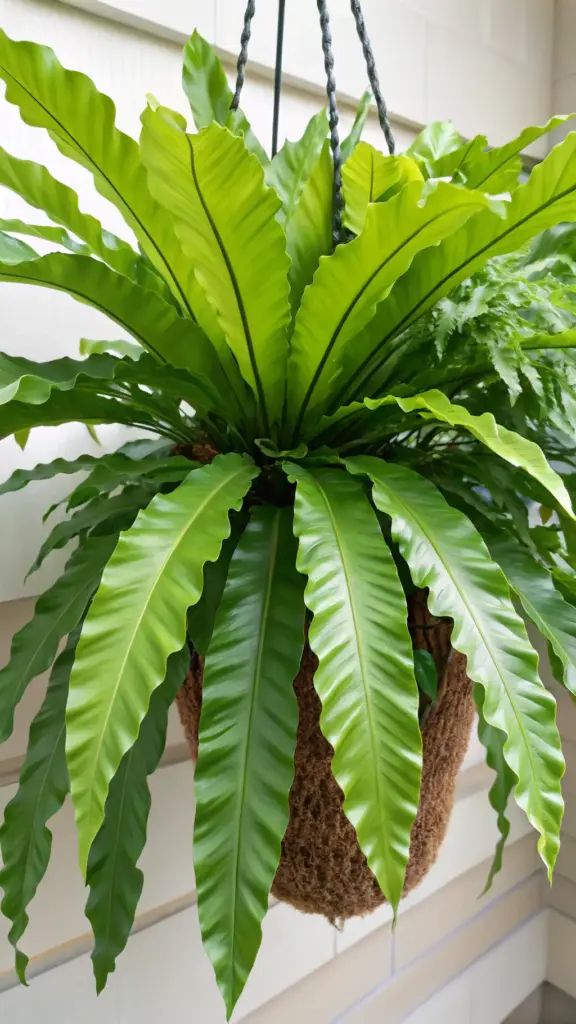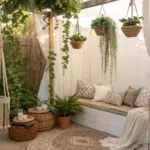10. Bird’s Nest Fern (Asplenium nidus) – The Architectural Green

If you’re looking for a plant that makes a statement with its shape and brings a touch of the serene, deep rainforest to your home, then you simply must meet the Bird’s Nest Fern (or Asplenium nidus). This isn’t your typical frilly, delicate fern; it’s got a robustness and a unique structure that’s truly captivating. It always reminds me of the lush undergrowth you’d find in a tropical paradise, maybe even somewhere like right here in beautiful San José del Cabo.
What Makes This Fern a “Living Sculpture”?
The most striking feature of the Bird’s Nest Fern is its broad, wavy, bright green fronds. These fronds are often undivided, unlike many other ferns, giving them a sleek, modern look. They unfurl from a central rosette, creating a shape that genuinely looks like a bird’s nest – hence the name!
Watching new fronds emerge is one of my favorite things about this plant. They start as tightly coiled little fiddleheads in the center and slowly unfurl, like a green scroll revealing itself. It’s a slow, mesmerizing process! The overall effect is very sculptural and architectural, making it a real focal point.
Finding the Perfect Shady Nook: Light for Your Fern
Unlike some of our sun-loving bloomers, the Bird’s Nest Fern prefers medium to low indirect light. In its natural habitat, it often grows as an epiphyte on trees, sheltered by the canopy above. So, you want to replicate those shady, dappled light conditions. Definitely avoid direct sun, as it can scorch those beautiful, broad fronds.
A spot a few feet away from an east or north-facing window is often perfect. It can even do quite well in rooms that don’t get a ton of natural light, making it a great low light fern option. I have one in a corner of my living room that doesn’t get direct sun, and it seems perfectly content, just radiating its calm, green energy.
Watering and Humidity: Creating a Rainforest Vibe
When it comes to watering, the key is to keep the soil consistently moist, but not waterlogged or soggy. Think of the damp floor of a rainforest – that’s the kind of moisture level it enjoys. Try not to let it dry out completely between waterings. And here’s a tip: try to water the soil around the base of the plant, rather than directly into the central “nest,” as water sitting in the rosette can sometimes lead to rot.
Even more important for this tropical fern care is humidity! Bird’s Nest Ferns love good humidity. If your home air is dry (especially in winter with heaters running), you’ll want to boost the humidity around your fern. Misting it regularly, placing it on a pebble tray with water, grouping it with other plants, or putting it in a naturally humid room like a bathroom can make a world of difference. I learned this quickly when some early fronds on mine got a bit of brown, crispy edging – upping the humidity fixed that right up!
Decorating with Architectural Elegance
The unique, nest-like shape of the Bird’s Nest Fern truly makes it a sculptural element in home decor. It has a bold yet calming presence that can really anchor a space. It’s particularly ideal for bathrooms where it will thrive in the higher humidity and add a spa-like, tranquil feel.
It also looks fantastic as a focal point in a contemporary setting, perhaps on a sleek plant stand or a minimalist shelf where its form can really be appreciated. Its bright, apple-green fronds bring a refreshing splash of nature indoors. It doesn’t trail like many of the other plants on our list, but its upright, vase-like shape commands attention in a sophisticated way.
A Furry Friend’s Best Friend: Pet-Safe Greenery
And here’s a wonderful bonus for all the pet parents out there: the Bird’s Nest Fern is generally considered non-toxic to cats and dogs! This is such great news because it means you can enjoy its stunning architectural beauty without worrying about your curious furry companions.
As someone who adores both plants and pets, finding pet safe houseplants that are also gorgeous is always a huge win. Knowing that this lush, vibrant fern can coexist peacefully with my four-legged friends just makes me love it even more. It’s a beautiful, safe, and serene addition to any home.
Conclusion
And there you have it – 10 truly gorgeous and surprisingly easy-to-care-for hanging plants that are ready to elevate your indoor jungle game! From the ever-reliable Pothos to the delicate String of Hearts, there’s a perfect trailing beauty for every style and every home.
Imagine the tranquility and fresh vibe these green wonders will bring to your space, whether you’re in a chic Dallas apartment or a cozy Chicago loft. Don’t be intimidated; remember, the key is choosing the right plant and understanding its basic needs.
So, which one will you pick to hang out with first? Go ahead, add a touch of living art to your home decor and enjoy the vibrant, mood-boosting benefits! Happy planting!









GIPHY App Key not set. Please check settings